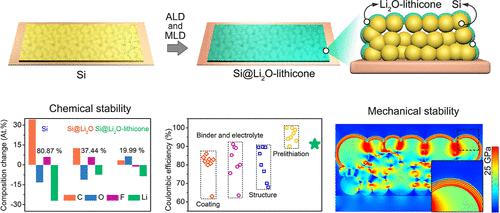当前位置:
X-MOL 学术
›
ACS Appl. Mater. Interfaces
›
论文详情
Our official English website, www.x-mol.net, welcomes your
feedback! (Note: you will need to create a separate account there.)
Atomic/Molecular Layer-Deposited Laminated Li2O–Lithicone Interfaces Enabling High-Performance Silicon Anodes
ACS Applied Materials & Interfaces ( IF 8.3 ) Pub Date : 2023-05-31 , DOI: 10.1021/acsami.3c02925 Jiabin Fang 1 , Jianguo Li 1 , Lijun Qin 1 , Aidong Li 2 , Hao Feng 1
ACS Applied Materials & Interfaces ( IF 8.3 ) Pub Date : 2023-05-31 , DOI: 10.1021/acsami.3c02925 Jiabin Fang 1 , Jianguo Li 1 , Lijun Qin 1 , Aidong Li 2 , Hao Feng 1
Affiliation

|
Silicon-based materials are of long-standing interest as the anodes for next-generation lithium-ion batteries, yet their low initial Coulombic efficiency and poor interfacial stability are lethal limitations. In this work, we used atomic layer deposition (ALD) and molecular layer deposition (MLD) techniques to fabricate a lithium-containing laminated Li2O–lithicone hybrid film (∼5 nm) on a silicon electrode. The laminated film provides an additional surface Li source around silicon cores, which can partially reimburse the Li loss during battery cycling. Characterization of interfacial components shows that such a laminated Li2O–lithicone interface undergoes gentle element changes and participates in a hybrid solid electrolyte interphase with Li2CO3, Li2O, LixPOFy, and LiF species. Finite element model analysis and morphology characterization demonstrate that the laminated structure design can help relieve the interfacial stress and thus retain the integrity and reactivity of the silicon composite anode during cycling. Moreover, the lithium-based laminated film leads to a fast Li+ migration kinetics on the surface of the electrode as revealed by the galvanostatic intermittent titration technique and density functional theory calculation. Benefiting from the above merits, a silicon anode with a 91.2% initial Coulombic efficiency, a rate performance of 1460 mA h g–1 at 2 A g–1, and a reversible capacity over 646 mA h g–1 after 850 cycles was achieved. This work exemplifies the advantages of lithium-based hybrid films precisely engineered by ALD/MLD techniques for improving performances of advanced silicon anode batteries and deepens understandings on the mechanism of interfacial stability and reaction kinetics.
中文翻译:

原子/分子层沉积层压 Li2O-Lithicone 界面实现高性能硅阳极
硅基材料作为下一代锂离子电池的阳极长期以来备受关注,但其初始库仑效率低和界面稳定性差是致命的限制。在这项工作中,我们使用原子层沉积 (ALD) 和分子层沉积 (MLD) 技术在硅电极上制备了含锂的层状 Li 2 O-硅氧烷混合膜 (~5 nm)。层压膜在硅芯周围提供了额外的表面锂源,可以部分补偿电池循环过程中的锂损失。界面组分的表征表明,这种层状 Li 2 O-硅氧烷界面经历了温和的元素变化,并参与了与 Li 2 CO的混合固体电解质界面3、Li 2 O、Li x POF y和 LiF 物种。有限元模型分析和形貌表征表明,层状结构设计有助于缓解界面应力,从而在循环过程中保持硅复合负极的完整性和反应性。此外,恒电流间歇滴定技术和密度泛函理论计算表明,锂基层压膜导致电极表面的锂离子快速迁移动力学。受益于上述优点,硅负极具有 91.2% 的初始库仑效率,在 2 A g –1下的倍率性能为 1460 mA hg –1,并在 850 次循环后实现了超过 646 mA hg –1的可逆容量。这项工作举例说明了通过 ALD/MLD 技术精确设计的锂基杂化薄膜在提高先进硅负极电池性能方面的优势,并加深了对界面稳定性和反应动力学机制的理解。
更新日期:2023-05-31
中文翻译:

原子/分子层沉积层压 Li2O-Lithicone 界面实现高性能硅阳极
硅基材料作为下一代锂离子电池的阳极长期以来备受关注,但其初始库仑效率低和界面稳定性差是致命的限制。在这项工作中,我们使用原子层沉积 (ALD) 和分子层沉积 (MLD) 技术在硅电极上制备了含锂的层状 Li 2 O-硅氧烷混合膜 (~5 nm)。层压膜在硅芯周围提供了额外的表面锂源,可以部分补偿电池循环过程中的锂损失。界面组分的表征表明,这种层状 Li 2 O-硅氧烷界面经历了温和的元素变化,并参与了与 Li 2 CO的混合固体电解质界面3、Li 2 O、Li x POF y和 LiF 物种。有限元模型分析和形貌表征表明,层状结构设计有助于缓解界面应力,从而在循环过程中保持硅复合负极的完整性和反应性。此外,恒电流间歇滴定技术和密度泛函理论计算表明,锂基层压膜导致电极表面的锂离子快速迁移动力学。受益于上述优点,硅负极具有 91.2% 的初始库仑效率,在 2 A g –1下的倍率性能为 1460 mA hg –1,并在 850 次循环后实现了超过 646 mA hg –1的可逆容量。这项工作举例说明了通过 ALD/MLD 技术精确设计的锂基杂化薄膜在提高先进硅负极电池性能方面的优势,并加深了对界面稳定性和反应动力学机制的理解。











































 京公网安备 11010802027423号
京公网安备 11010802027423号